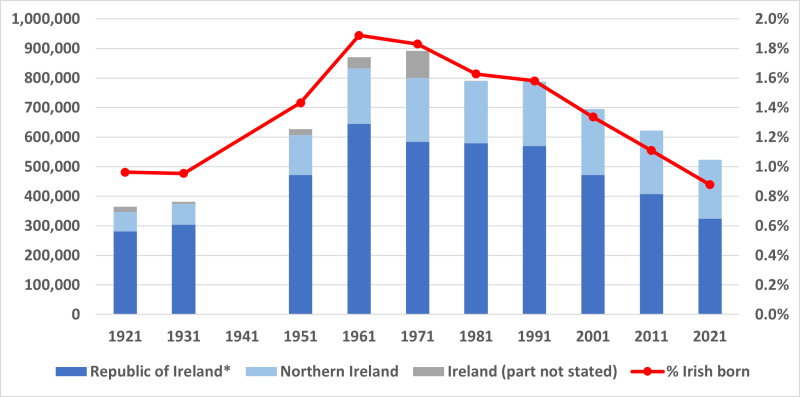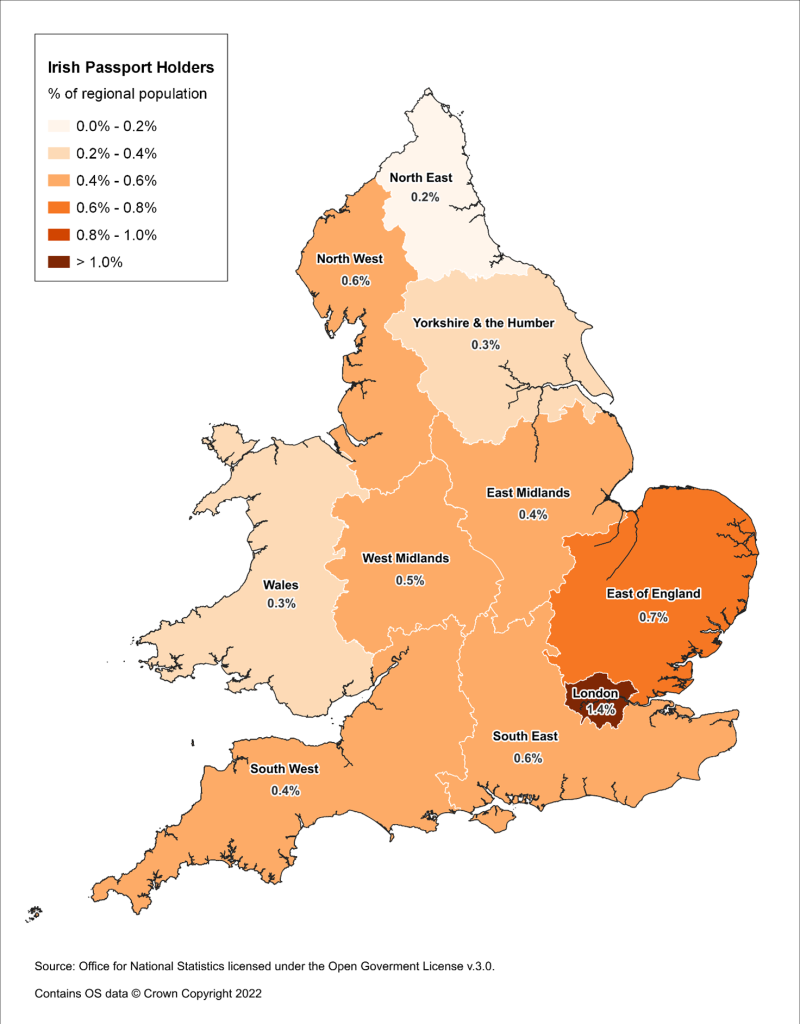Population by Country of Birth and Passports Held
Census release
 On 2 November 2022, the Office for National Statistics (ONS) released a new set of population data from the 2021 Census in England and Wales. The data and supporting commentary cover ‘Demography and Migration’ and include statistics on country of birth and passports held.
On 2 November 2022, the Office for National Statistics (ONS) released a new set of population data from the 2021 Census in England and Wales. The data and supporting commentary cover ‘Demography and Migration’ and include statistics on country of birth and passports held.
Irish in Britain and the community organisations that make up its membership rely on this information to ensure the community’s profile is understood, patterns can be identified, and needs can be planned and provided for.
What the numbers say
The data from the 2021 shows a significant reduction of people born in Ireland in comparison to the previous 2011 Census. In particular, the number of people born in Ireland and living in England and Wales in 2021 was 523,014 (that is about 1 percent of the total resident population). Of these, 324,670 were born in the Republic of Ireland and 198,344 were born in Northern Ireland.
Figure 1 - England and Wales Population by Country of Birth: 1921 - 2021

This represents a decrease of over 99,000 people (-16 percent) since a decade ago, when the Irish-born population totalled 622,345 (of which 407,357 were born in the Republic of Ireland).
This significant change has occurred against the wider population trend outlined in the Census data. Overall, the size of the non-UK born population in England and Wales has risen from 7.5 million in 2011 to 10 million in 2021 (+33 percent). (See graph below)
As indicated by Figure 1 this decrease of the Irish-born population confirms a trend, which had started in the 1970s, after the number had reached a peak of nearly 900,000 residents.
Passport holders
In addition to ‘country of birth’, since 2011 the Census has also collected data on ‘passports held’; these data tell a different part of the story. In 2021, there were 364,725 people living in England and Wales and holding a passport issued by the Republic of Ireland. This number represents only a small reduction (-2.1 percent) when compared to the 2011 Census (372,389).
“It is a bit early to speculate too much on the reasons behind this difference" notes Dr Alessio D’Angelo, "Among the other things, a Brexit effect might be at play here. We will find out more once data on Ethnicity is released later this month and a break-down analysis is undertaken."

Figure 2 – Irish Passport Holders: Census 2021
For the time being, the Census data confirms that the geographical distribution of Irish citizens across England and Wales is quite uneven.
As indicated in the map, London remains the region with the largest proportion of residents (1.4 percent), followed by the East of England (0.7 percent), whilst the Irish presence is significantly smaller in the North East (0.2 percent), Yorkshire and Humberside (0.3 percent) and Wales (0.3 percent).
Significance of these findings
These latest ONS data confirm that the numbers of Irish-born residents in England and Wales are decreasing. There are many factors which may have contributed to this: the health/older age profile of this population is highly significant, but return migration and, most recently, Brexit and Covid are also likely to play a significant role.
As highlighted by Professor Louise Ryan: “The Irish-born population is falling because of two obvious factors: declining migration from Ireland to Britain coupled with the skewed ageing profile, and hence higher mortality, of Irish migrants already living in Britain. In other words, the Irish in Britain are disproportionately older and their numbers are declining.”
It is essential that we understand these population trends to present and contextualise an accurate and fully informed profile of the community. We will not be able to do this until the release of more detailed data by the ONS over the next six months.
As pointed out by Dr Alessio D’Angelo, “These will include ‘multivariate’ data, which will allow us to combine variables and explore relationships between different socio-economic and demographic characteristics, as well as examining these across local communities and – by comparing with the previous Census – over time.”
Irish in Britain has commissioned* a bespoke analysis of this data and will be publishing reports on the Irish community in England, Wales and metropolitan areas of Britain over the coming months. Scotland's census took place in 2022 those data reports will be released in 2024.
This analysis will include in-depth reports on health disparities, demographic data about the community, and regional breakdowns to understand patterns and changes from 2011. We plan to release full reports on this data in the spring of 2023 and to use them to inform the work of Irish in Britain and our partner organisations.
Professor Louise Ryan states that “the Irish community infrastructure in Britain remains strong and vibrant, often supported by funding from the Irish, rather than British, government. However, as the needs of older Irish people become more acute as they enter advanced old age, often with poor health, it is imperative that community organisations receive sufficient support to carry on their vital work.”
* About this project - This census explainer is part of a collaborative project between Irish in Britain and a team of researchers led by Dr Alessio D’Angelo, Associate Professor at the University of Nottingham, and which includes Dr Neil Kaye, Research Fellow at UCL’s Institute of Education, Dr Alastair Munro, Researcher at the University of Nottingham, and Professor Louise Ryan, Director of Global Diversities and Inequalities Research Centre at London Metropolitan University.
To go back to main Census analysis page click here.